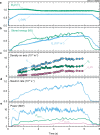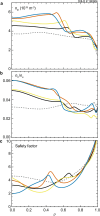A high-density and high-confinement tokamak plasma regime for fusion energy
- PMID: 38658758
- PMCID: PMC11096097
- DOI: 10.1038/s41586-024-07313-3
A high-density and high-confinement tokamak plasma regime for fusion energy
Erratum in
-
Author Correction: A high-density and high-confinement tokamak plasma regime for fusion energy.Nature. 2024 Jun;630(8016):E4. doi: 10.1038/s41586-024-07545-3. Nature. 2024. PMID: 38778118 Free PMC article. No abstract available.
Abstract
The tokamak approach, utilizing a toroidal magnetic field configuration to confine a hot plasma, is one of the most promising designs for developing reactors that can exploit nuclear fusion to generate electrical energy1,2. To reach the goal of an economical reactor, most tokamak reactor designs3-10 simultaneously require reaching a plasma line-averaged density above an empirical limit-the so-called Greenwald density11-and attaining an energy confinement quality better than the standard high-confinement mode12,13. However, such an operating regime has never been verified in experiments. In addition, a long-standing challenge in the high-confinement mode has been the compatibility between a high-performance core and avoiding large, transient edge perturbations that can cause very high heat loads on the plasma-facing-components in tokamaks. Here we report the demonstration of stable tokamak plasmas with a line-averaged density approximately 20% above the Greenwald density and an energy confinement quality of approximately 50% better than the standard high-confinement mode, which was realized by taking advantage of the enhanced suppression of turbulent transport granted by high density-gradients in the high-poloidal-beta scenario14,15. Furthermore, our experimental results show an integration of very low edge transient perturbations with the high normalized density and confinement core. The operating regime we report supports some critical requirements in many fusion reactor designs all over the world and opens a potential avenue to an operating point for producing economically attractive fusion energy.
© 2024. The Author(s).
Conflict of interest statement
The authors declare no competing interests.
Figures







References
-
- Conn RW, et al. Economic, safety and environmental prospects of fusion reactors. Nucl. Fusion. 1990;30:1919. doi: 10.1088/0029-5515/30/9/015. - DOI
-
- Yeom JH, et al. System analysis study for Korean fusion DEMO reactor. Fusion Eng. Des. 2013;88:742. doi: 10.1016/j.fusengdes.2013.02.092. - DOI
-
- Zhuang G, et al. Progress of the CFETR design. Nucl. Fusion. 2019;59:112010. doi: 10.1088/1741-4326/ab0e27. - DOI
-
- Lux H, et al. Uncertainties in power plant design point evaluations. Fusion Eng. Des. 2017;123:63. doi: 10.1016/j.fusengdes.2017.01.029. - DOI

